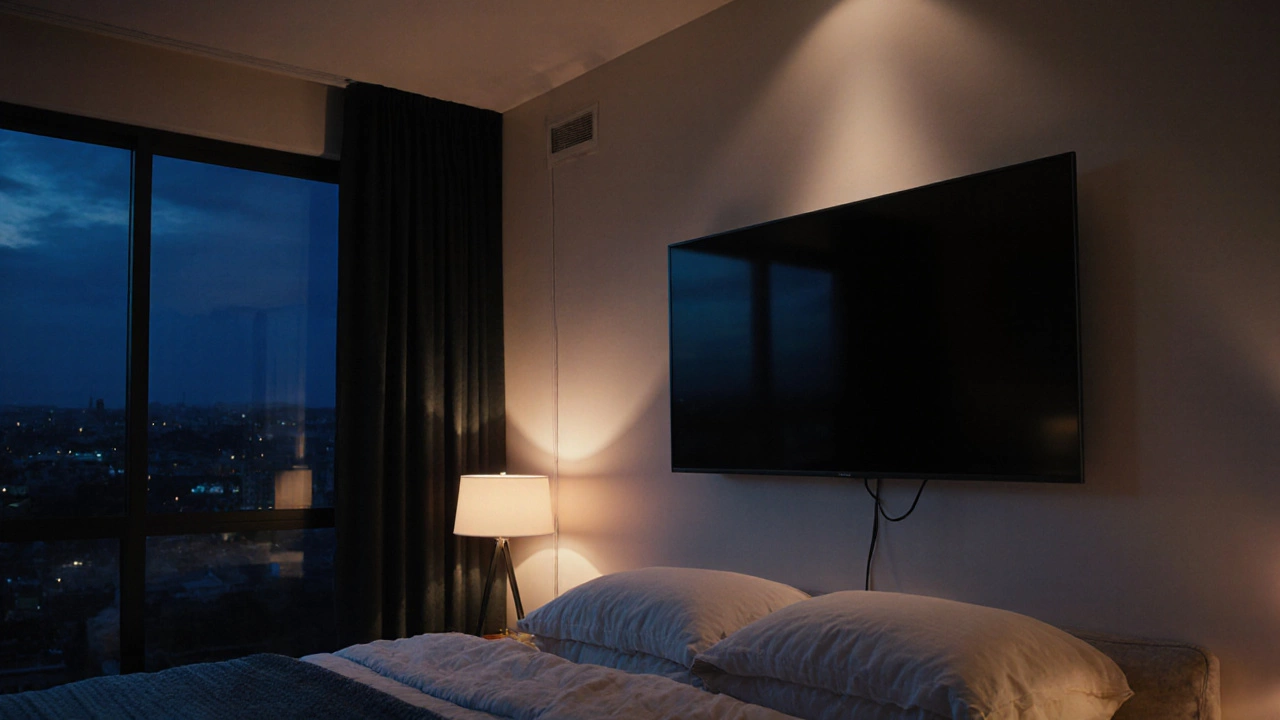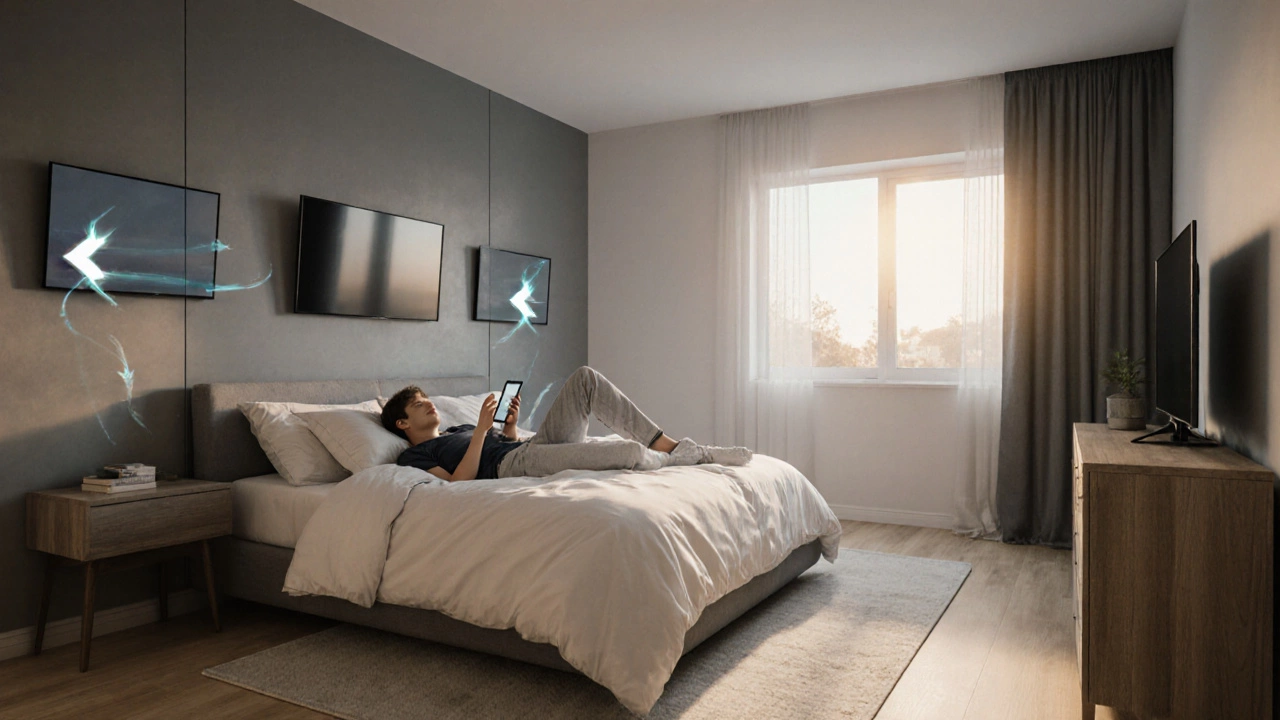TV Placement Calculator
Find Your Ideal TV Placement
Calculate the optimal viewing distance, height, and direction for your bedroom TV setup.
Trying to decide where to put the TV in your bedroom can feel like a puzzle. You want a comfortable view, minimal glare, and maybe even a dash of good energy. Below we break down the factors that decide the perfect direction for your TV, so you can binge‑watch without straining your neck or fighting the light.
Key Takeaways
- Place the TV at eye level when you’re seated or lying down for the most ergonomic view.
- Mount the screen on a solid wall opposite the bed, avoiding windows to reduce glare.
- Use neutral colors and avoid placing the TV directly behind the headboard if you follow FengShui principles.
- Incorporate blackout curtains or dimmable lighting to control reflections.
- Choose a wall‑mount for a cleaner look, but a sturdy stand works well if you need flexibility.
1. Why Direction Matters
When you think about TV placement, the first thing that comes to mind is "where does it look best?" The answer depends on three core ideas: the viewing angle, the bedroom layout, and the flow of energy in the space.
Viewing angle is the angle between your eyes and the screen. Studies show that angles wider than 30° to either side start to strain the neck and reduce perceived picture quality. Keep the main seating (your bed or a lounge chair) within a 15°‑30° zone for the sharpest experience.
Next, the bedroom layout influences how you move around the room. A TV placed directly above a window will cause reflections, while a screen on the far wall may force you to sit too far away, shrinking the image.
For those who care about FengShui, direction also signals the flow of chi. The traditional advice: avoid putting the TV directly behind the headboard and keep it in the "command position" - where you can see the screen without being directly in line with the door.
2. Mapping the Bedroom Directions
Start by drawing a simple floor plan. Mark the entry door, windows, bed, and any built‑in closets. Then identify the cardinal directions (north, south, east, west). Here’s how each side typically behaves:
- North wall: Cooler light, good for a TV that won't get heated by sunlight.
- South wall: Receives the most natural light; risk of glare unless you use blinds.
- East wall: Morning sun can wash out the picture; ideal if you watch mainly at night.
- West wall: Evening sun hits directly; consider anti‑glare screens or tilt‑adjustable mounts.
If the bed is centered on the opposite wall from a window, that wall often becomes the sweet spot for a TV - you get a clear view and shrink the chance of sunshine glare.
3. Ergonomics: Eye Level and Distance
Measure the distance from the headboard to the wall. The ideal viewing distance for a 55‑inch 4K TV is roughly 1.5× the screen diagonal, about 6.9feet (2.1m). If your room is smaller, choose a smaller screen or sit closer, but keep the screen height at eye level when you’re lying flat. Use a wall‑mount that tilts upward about 10°‑15° to align the center of the screen with your eyes.
For a stand‑alone TV, a low‑profile TV stand that places the screen top at about 42‑48inches (106‑122cm) from the floor works well for most adults.
4. Controlling Light and Glare
Lighting is the silent killer of bedroom TV sessions. Follow these steps:
- Install dimmable recessed lights or a bedside lamp with a warm color temperature (2700‑3000K).
- Use blackout curtains or blinds on windows that face the TV direction.
- Apply an anti‑glare screen filter if you can’t avoid a window behind the TV.
- Set the TV’s picture mode to "Cinema" or "Warm" for a softer glow at night.
When you combine soft ambient lighting with controlled natural light, the TV’s picture stays vivid and eye strain stays low.
5. Cable Management & Safety
A tidy setup not only looks better but also reduces tripping hazards. Here’s a quick guide:
- Cable management kits: Use in‑wall rated power and HDMI runes to hide cords behind the wall.
- Secure the wall‑mount with at least two studs or a heavy‑duty metal bracket rated for the TV’s weight.
- Keep power strips away from the bed to avoid accidental unplugging while reaching for the remote.

6. Wall‑Mount vs. TV Stand: Quick Comparison
| Feature | Wall‑Mount | TV Stand |
|---|---|---|
| Space Saving | Excellent - no floor footprint | Requires floor space, may clutter |
| Installation Difficulty | Moderate - needs studs & tools | Easy - just set it on the floor |
| Adjustability | Tilt & swivel options | Fixed height, limited tilt |
| Safety | Secure if properly mounted; less tip‑over risk | Higher tip‑over risk, especially with pets/kids |
| Cost | $100‑$300 for mount + installation | $150‑$400 for quality stand |
If you love a sleek look and have the wall studs, the mount wins. If you move frequently or want a quick setup, a sturdy stand is the way to go.
7. DIY Checklist for the Perfect Bedroom TV Setup
- Measure room dimensions and decide on TV size (recommended: 40‑55in for typical bedrooms).
- Identify the wall opposite the bed and check for studs.
- Confirm the wall’s direction (north/south/etc.) and note any windows.
- Choose wall‑mount or stand based on space and skill level.
- Mark eye‑level height (around 42‑48in from floor) and pre‑drill holes.
- Run power and HDMI cables through in‑wall connectors or a cable‑conceal kit.
- Install blackout curtains or dimmable lights on the TV side wall.
- Mount TV, test viewing angle from the bed, adjust tilt if needed.
- Set picture mode, calibrate brightness for nighttime viewing.
- Keep remote within reach and store extra cords in a small basket.
Follow these steps, and you’ll have a comfortable, glare‑free viewing spot that blends with your bedroom décor.
Frequently Asked Questions
Is it okay to put the TV directly opposite the window?
It’s possible, but you’ll need strong light control - blackout curtains, blinds, or an anti‑glare screen. Without those, daytime viewing becomes washed out and may cause eye strain.
What height should a wall‑mounted TV be in a bedroom?
Aim for the screen’s centre to sit about 42‑48inches (106‑122cm) from the floor when you’re lying flat. A tilt of 10°‑15° helps align the view with your eyes.
Does FengShui really matter for TV placement?
Many people find the "command position" principle helpful - keep the TV in clear sight of the door but not directly behind the headboard. This arrangement encourages a sense of security and reduces restless sleep.
Should I use a TV stand if I have a small bedroom?
A low‑profile stand can work, but it eats floor space. If space is tight, a wall‑mount is usually the smarter choice, freeing up room for nightstands or a small dresser.
How can I hide cables without renovating the wall?
Use surface‑mount raceways that stick to the wall and can be painted over. They’re inexpensive, easy to install, and keep cords tidy without cutting into plaster.
With the right direction, lighting, and mounting method, your bedroom TV becomes a relaxing retreat rather than a design afterthought.


